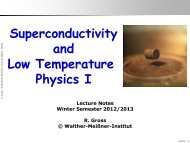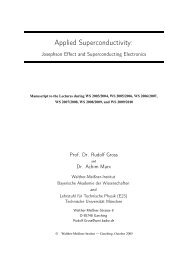Design, Fabrication and Characterization of a Microwave Resonator ...
Design, Fabrication and Characterization of a Microwave Resonator ...
Design, Fabrication and Characterization of a Microwave Resonator ...
Create successful ePaper yourself
Turn your PDF publications into a flip-book with our unique Google optimized e-Paper software.
2.1 The Coplanar Transmission LinewithOne can calculate the effective permittivityε e f f = 1 + q 1 (ε r1 − 1) + q 2 (ε r2 − ε r1 )q 1 = 1 [K(k 1diel ) K(k)2 K(k1diel ′ ) K(k ′ ) + K(k ] −11)K(k1 ′ ) ,q 2 = 1 [K(k 2diel ) K(k)2 K(k2diel ′ ) K(k ′ ) + K(k ] −11)K(k1 ′ ) .The impedance here is equal to the one <strong>of</strong> a single layer substrate given by (2.10).It can be shown that the second dielectric layer <strong>of</strong> SiO 2 with ε r2 = 4.7 influences theimpedance for values <strong>of</strong> H 2 larger than 1.7 µm [12].2.1.5 DispersionWith the help <strong>of</strong> the spectral domain method an empirical formula to compute ε e f f <strong>of</strong> a CPWis obtained in reference [18].√ε e f f ( f ) = √ ε e f f + (√ ε r − √ ε e f f )1 + aF −1.8 (2.14)whereF = f / f T E is the normalized frequencywith f T E = c 0 /(4H √ ε r − 1), the cut<strong>of</strong>f frequency for the lowest-order TE mode,ε e f f is the effective permittivity at the quasi-static limit.The parameteris calculated with( ) Slog(a) ≈ ulog + vWu ≈ 0.54 − 0.64q + 0.015q 2 ,v ≈ 0.43 − 0.86q + 0.540q 2 ,q = log S H .With an accuracy <strong>of</strong> 5 %, the formula is valid into the THz regime in the ranges given inTable 2.1.Calculations show that for our designs, explained in detail in chapter 3, all ranges, exceptfor the ratio <strong>of</strong> the inner strip to height <strong>of</strong> the substrate, are in the application range. Sinceno better formula for the designs with parameters which are out <strong>of</strong> range could be found,(2.14) was applied to these designs, too. The cut<strong>of</strong>f frequency f T E for Sapphire as substratematerial is 45.4 GHz, for Silicon as substrate material we evaluate 54.4 GHz.Figure 2.7 shows the effective dielectric constant for Silicon <strong>and</strong> Sapphire as substratematerials. We see that dispersion is negligible in the measurement range.9
















